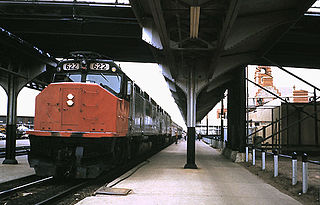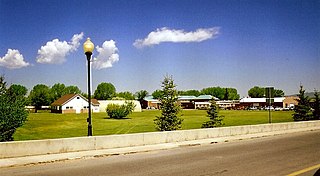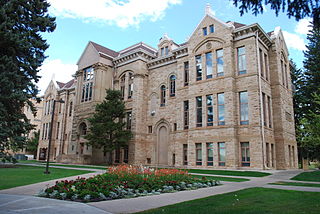
The Wyoming State Capitol is the state capitol and seat of government of the U.S. state of Wyoming. Built between 1886 and 1890, the capitol is located in Cheyenne and contains the chambers of the Wyoming State Legislature as well as the office of the Governor of Wyoming. It was designated a U.S. National Historic Landmark in 1987. The Capitol underwent an extensive three-year renovation and reopened to the public on July 10, 2019.

Fort Fetterman was constructed in 1867 by the United States Army on the Great Plains frontier in Dakota Territory, approximately 11 miles northwest of present-day Douglas, Wyoming. Located high on the bluffs south of the North Platte River, it served as a major base for the start of several United States military expeditions against warring Native American tribes. The fort is listed on the National Register of Historic Places.

The Cheyenne Depot Museum is a railroad museum in Cheyenne, Wyoming, United States. It is located inside the 1880s Union Pacific Railroad depot. A National Historic Landmark, the station was the railroad's largest west of Council Bluffs, Iowa, and a major western example of Richardsonian Romanesque architecture.
The Wyoming Governor's Mansion is the official residence of the governor of Wyoming. The current mansion was built during 1976 in Cheyenne.

The Wyoming State Hospital, once known as the Wyoming State Insane Asylum, is located in Evanston, Wyoming, United States. The historic district occupies the oldest portion of the grounds and includes fifteen contributing buildings, including the main administrative building, staff and patient dormitories, staff apartments and houses, a cafeteria and other buildings, many of which were designed by Cheyenne, Wyoming architect William Dubois. Established in 1887, the historic buildings span the period 1907-1948. At one point it was common for new hall additions to be named after the counties in Wyoming. The recent addition of Aspen, Cottonwood, and Evergreen halls do not follow this trend.

Old Main, built in 1886, was the first and is the oldest remaining building on the University of Wyoming campus, in Laramie, Wyoming. The building currently houses University administration.

The Rawhide Buttes Stage Station, the Running Water Stage Station and the Cheyenne–Black Hills Stage Route comprise a historic district that commemorates the stage coach route between Cheyenne, Wyoming, and Deadwood, South Dakota. The route operated beginning in 1876, during the height of the Black Hills Gold Rush, and was replaced in 1887 by a railroad.
The Fort Laramie Three-Mile Hog Ranch was built to serve as a social center away from the soldiers' post at historic Fort Laramie. Fort Laramie was a 19th-century military post in eastern Wyoming. It became notorious as a place for gambling and drinking, and for prostitution, with at least ten prostitutes always in residence. The location is notable as an example of one of only a few military bordellos still standing in the United States by 1974, the time of its nomination to the National Register of Historic Places The Fort Laramie site was one of a number of so-called "hog ranches" that appeared along trails in Wyoming.

The Masonic Temple in downtown Casper, Wyoming is a Masonic hall, built in 1914 during a boom time initiated by the development of the Salt Creek Oil Field. Located on a corner site, the temple remains essentially as it was designed by Casper architect Homer F. Shaffer. The four story light-colored brick building rests on a raised basement and is topped by a crenelated parapet. The original windows have been replaced with vinyl units but retain the one-over-one appearance of the originals. Windows extend over the west and south sides. The north side is blank, while the east side is the building's rear facade and has fire escapes and a few windows.

St. Mark's Episcopal Church is a historic church in Cheyenne, Wyoming.

William Dubois (1879–1953) was an American architect and politician. He was a prolific architect in Wyoming and nearby states, and served five terms in both houses of the Wyoming Legislature.

The Tivoli Building is a historic building at 301 West Lincolnway in downtown Cheyenne, Wyoming, and a part of the Downtown Cheyenne Historic District.
Frederic Hutchinson "Bunk" Porter, Sr., sometimes referred to as Frederick Hutchinson Porter, was an American architect based in Cheyenne, Wyoming. He was active from 1911 to approximately 1965. He designed many of Cheyenne's most important public and commercial buildings and also designed several buildings at the University of Wyoming, including War Memorial Stadium and the Agriculture Building. A number of his works are listed on the U.S. National Register of Historic Places.
Leon C. Goodrich was an American architect of Casper, Wyoming. A number of his works are listed on the National Register of Historic Places.
The following is a timeline of the history of the city of Cheyenne, Wyoming, USA.

Fort Steele, also known as Fort Fred Steele, was established to protect the newly built Union Pacific Railroad from attacks by Native Americans during construction of the transcontinental railroad in the United States. The fort was built in 1868 where the railroad crossed the North Platte River in Carbon County, Wyoming. Work on the fort was carried out by military and civilian labor. Fort Steele was one of three forts built on the line. Fort Sanders near Laramie and Fort D.A. Russell at Cheyenne were the other railroad forts. Fort Steele was named for the recently deceased General Frederick Steele.

The Castle on 19th Street or 19th Street Castle is a Mission Revival style house in Cheyenne, Wyoming. It was built in 1914 for local businessman Thomas Heaney, who operated the Atlas Theatre in Cheyenne. Heaney also operated the Tivoli Bar and Restaurant and became a Wyoming state senator representing Laramie County. Heaney's residence features a three-story corner tower with a broad overhanging tiled and hipped roof, with a stucco parapet surrounding the remainder of the roof, ornamented with projecting crests. A loggia with three arches fronts the house, ornamented with projecting squared beams. The driveway goes through the leftmost arch, flanked by a retaining wall, on its way to the rear of the house. The interior was converted for apartments.

The Downtown Cheyenne Historic District in Cheyenne, Wyoming is a historic district that was listed on the National Register of Historic Places in 1978. It is an area of about seven blocks, in the core of the original business district of Cheyenne, and home of many of the first masonry commercial buildings in Cheyenne.

The Durlacher House, or Durlacher Residence is a Queen Anne style house in Laramie, Wyoming. It was built between 1875 and1878 by Charles Klingerman. In 1878 it was purchased by German immigrants Simon and Hannah Durlacher.

The Federal Office Building-Cheyenne, at 308 W. 21st St. in Cheyenne, Wyoming, is a Classical Revival-style building built in 1932. It was listed on the National Register of Historic Places in 2000.

















